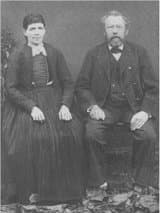Hengstler's success story began in 1846 and, thanks to the high dynamism and innovative strength of our employees, we are a leading manufacturer of industrial counting and control components such as counters, rotary encoders and relays. With printers and cutters, we have sensibly expanded our portfolio. We are proud of our roots, but we know that a long history alone is no guarantee of success.
The Hengstler original cell was created in 1846 in the master workshop of Johannes Hengstler with the production of clock gongs.

The company founder Johannes Hengstler (the elder) with his wife Anna née Hauser
In 1912, the production of precision turned parts began. In 1926, Hengstler took over the Efunda company and thus the production of counting devices, which became increasingly successful despite the economic crisis at the end of the twenties and the partial dismantling after the end of the war. From 1954 onwards, the company boomed and in order to get the necessary employees, Hengstler built 100 company apartments for them. A technological milestone was the acquisition of the first plastic injection moulding machine in order to be able to produce plastic parts in-house. This, in turn, made it possible to implement new product concepts, such as the revolutionary 400 meter system, which was introduced to the market in 1957. It was not until 1961 that the watch gong production was sold. The first foreign subsidiary was founded in Great Britain as early as 1962, and others followed at intervals of several years. Between 1962 and 1966, 60 houses were built for the employees as part of a self-help program. 1969 was the birth of "time recording" – the slogan of "ai laik flexitime" became a perennial favorite. The first products for recording employee attendance time were based on counters, and these "Flextimers" were sold throughout Europe. Electronic systems followed and in 1980 a completely new, microprocessor-controlled device family with operator guidance via screen was presented.

Hauptstrasse 69, residential building with first factory building
The start of relay production, through the takeover of Haller-Relais, Wehingen, took place in 1983.
Ten years later, turned parts production was abandoned and a joint venture company was founded in Qingdao, China. The owner family slowly withdrew due to the lack of their own successor and appointed external managers. In 1993, the first modular encoders with Optoasic were launched on the market – high-tech from Aldingen. 1995 became a decisive year: Hengstler was taken over 100% by the US group Danaher. In the same year, the previous meter competitor Veeder-Root was integrated into Aldingen and a year later KACO Elektrotechnik/Heilbronn, with its relay business, was taken over. In 1998, the time recording and access control division was sold to MBB-Gelma and in return its encoder business could be taken over. In early autumn 2002, Hengstler bought the thermal printer division from BDT, Rottweil. Over the years, the Danaher portfolio has grown into a large number of science and technology companies to a more than $20 billion corporation. In July 2016, Danaher was separated into two independent, publicly traded companies: Danaher and Fortive. Fortive is now a company focused on industrial growth innovations in field instrumentation, transportation and process automation.

The relay factory in Wehingen in 1983
A long, varied and interesting history of the Hengstler company, which can only be presented here in brief strokes.
Clock gongs and other historical Hengstler material can be seen in the new Aldinger Museum - in the old home of Hengstler's founder Johannes Hengstler, Hauptstr. 69.
1998 Handover of the Time + Access business unit to MBB-Gelma
At the same time, takeover of their range of angle encoders

The first rotation counters
Chronological